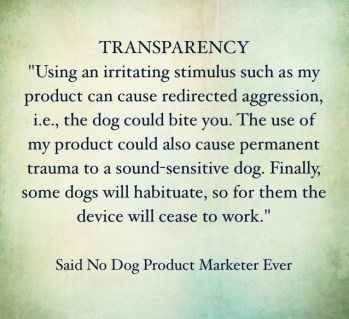Barks Blog
Using Annoying or Scary Sounds for Dog Training
Let’s pretend you saw an ad for a new dog training product. It read something like this:
Introducing the Noise-Aided Obedience Device (NOD)! Never have trouble with your dog again. When you jerk or flap the lead attached to your dog’s collar or harness to punish him or to force him into the correct position, the device adds a noise that makes the leash jerking or flapping extra unpleasant. You can get instant compliance! That is, for some dogs. Some won’t be bothered by the noise or will get used to it. Some noise-sensitive dogs will be so traumatized you may never get them out from under the bed again. But for the majority of dogs, the “NOD” makes the leash correction just a bit worse. And for you as the trainer it feels great! You are actually DOING something about your dog’s naughty behavior.
Add an auditory aversive to the physical one! Buy the NOD (along with my DVD and special gear) today!
Actual Products on the Market
The ad is fake but unfortunately, the products are real. A reader introduced me to two different products that operate as I described above. Both attach to or are part of the dog’s gear. These are mechanical, not electronic. (There are electronic devices that work similarly as well.) One makes a zipping noise and one rings like a bell. They make these noises when the handler shakes, pulls, or jerks the leash. But the creators of these products don’t describe them the way I did above. Instead, they use words and phrases like the following:
- Gentle method
- Sound-based training
- Gets the dog’s attention
- Strengthens your dog’s concentration abilities
- Technologically superior
- Helps dogs understand cause and effect
- Kind training method
- Helps the dog focus
- Helps you guide your dog to the correct position
- Dog learns to pay attention to you
- Enables communication with the dog
- Hastens the learning process
The soft marketing language for both products strongly implies that there is something intrinsic to the sound that causes the dog to become obedient. It supposedly allows some kind of special communication between the owner and dog. Also, they don’t explain exactly what you do to operate the product. This neatly skirts the real consequences being used: the trainer is performing actions that cause physical pressure, commotion, and noise. When these devices work, they work by helping to annoy, startle, or scare the dog into compliance.
No Free Lunch
This type of product marketing, common in the dog training world, masks the actual consequences used to attempt to change dogs’ behavior. The focus is on the “special” sound. This draws attention away from the leash jerking or flapping and the commotion close to the dog’s ears. Even though the noises are probably unpleasant for most dogs, they are not necessarily the main source of discomfort. And make no mistake: it is discomfort that is driving the behavior change. The sound isn’t magically making the dog feel great for correct choices.
Even though it is a favorite marketing claim, a neutral stimulus can’t be used (without conditioning) to change a dog’s behavior. Here’s a previous post on that: “It’s Not Painful. It’s Not Scary. It Just Gets the Dog’s Attention!” To change behavior you generally need either an appetitive stimulus (for example, food) or an aversive stimulus (for example, shock). You can also use stimuli that have been conditioned to predict these things. An example of a typical predictor of an appetitive stimulus would be a clicker. An example of a predictor of an aversive stimulus would be the warning beep used on some shock collars.
The odd thing is that the noises these particular products make do not fit neatly into a category. The sounds and sensations they make may be intrinsically aversive or not, depending on the dog. The one thing that is certain is that they are not used as predictors. Thus, the claims about their special communication functions are off the mark.
The noise happens at the same time as the leash motion. Not before. The sounds can’t be used as warnings. They are about as communicative as throwing sand at someone you are already yelling at.
Turn Off the Sound
It can be hard to find a video that shows the methods. Makers of these types of products generally display “before and after” type videos. To see the device in action, you often need to buy a DVD. But if you look hard enough, you can usually find a couple of short examples of the actual process.
If you have a question about such a product, try to find a video of it in use. (If you can’t find one, that tells you something as well.) If you do find such a video, watch with the sound turned off. In general, that will show you the actions and actual consequences being used to train the dog. Watch the body language of the dog as well, and heed the edits. It’s pretty common to edit or switch the camera angle immediately after a “correction” is made so the dog’s response is not visible.
Transparency

- What exactly will happen to my dog when she gets it right? I will stop the annoying movements and sounds. Sometimes I will also praise her, and in some cases I will give her food.
- What exactly will happen to my dog when she gets it wrong? I will flap or jerk the leash, and my product will additionally make a noise close to her head.
- Are there any less invasive alternatives to what you propose? Yes. Leash walking and other behaviors can be taught using food, toys, play, or other things the dog likes and wants. These are less invasive since there is little chance of scaring or hurting the dog. That type of training is generally enjoyable for the dog when done well. I should also note that using an irritating stimulus such as my product can cause redirected aggression towards the handler, i.e., the dog could bite you. Also, the use of my product could be permanently damaging to a sound-sensitive dog. Finally, the responses to sound by individual dogs vary. So some dogs will habituate to the noise and stop responding.
The above answers depend on very basic behavior analysis and what we know about the negative effects of aversive use. If you actually ask these questions and get non-specific answers about communication and focus and getting the dog’s attention instead, that should tell you what you need to know.
The devices I saw were not magically communicative or innovative in any way. It’s sad that such things are still being marketed and that their producers do not describe how they really work.
A big thanks to Vicky Carne, publisher of Dog Coach Videos, who brought these types of products to my attention.
Copyright Eileen Anderson 2016


